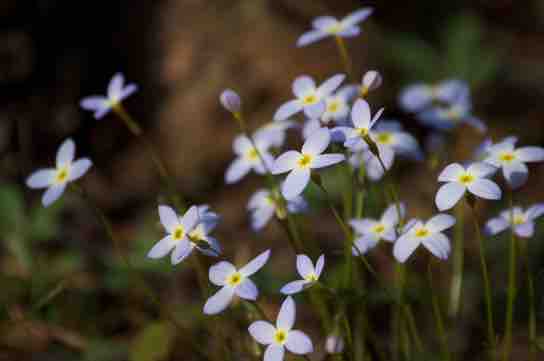The Blue Light Responses
Phototropism is the directional bending of a plant toward or away from a light source of blue wavelengths of light. Positive phototropism is growth toward a light source , while negative phototropism (also called skototropism) is growth away from light. Several proteins use blue light to control various physiological processes in the plant.

Blue light response of azure bluets
Azure bluets (Houstonia caerulea) display a phototropic response by bending toward the light.
Phototropins and Physiological Responses
Phototropins are protein-based receptors responsible for mediating the phototropic response in plants. Like all plant photoreceptors, phototropins consist of a protein portion and a light-absorbing portion, called the chromophore, which senses blue wavelengths of light. Phototropins belong to a class of proteins called flavoproteins because the chromophore is a covalently-bound molecule of flavin.
Phototropins control other physiological responses including leaf opening and closing, chloroplast movement, and the opening of stomata. However, of all responses controlled by phototropins, phototropism has been studied the longest and is the best understood.
Phototropism and Auxin
In 1880, Charles Darwin and his son Francis first described phototropism as the bending of seedlings toward light. Darwin observed that light was perceived by the the apical meristem (tip of the plant), but that the plant bent in response in a different part of the plant. The Darwins concluded that the signal had to travel from the apical meristem to the base of the plant, where it bent.
In 1913, Peter Boysen-Jensen conducted an experiment that demonstrated that a chemical signal produced in the plant tip was responsible for the plant's bending response at the base. He cut off the tip of a seedling, covered the cut section with a permeable layer of gelatin, and then replaced the tip. The seedling bent toward the light when illuminated even though the layer of gelatin was present. However, when impermeable mica flakes were inserted between the tip and the cut base, the seedling did not bend.
A refinement of Boysen-Jensen's experiment showed that the signal traveled on the shaded side of the seedling. When the mica plate was inserted on the illuminated side, the plant still bent toward the light. Therefore, the chemical signal from the sunlight, which is blue wavelengths of light, was a growth stimulant; the phototropic response involved faster cell elongation on the shaded side than on the illuminated side, causing the plant to bend. We now know that as light passes through a plant stem, it is diffracted and generates phototropin activation across the stem. Most activation occurs on the lit side, causing the plant hormones indole acetic acid (IAA) or auxin to accumulate on the shaded side. Stem cells elongate under the influence of IAA .

Phototropism and the distribution of auxin
Phototropism is the growth of plants in response to light. When the sun is positioned almost directly over the plant, the hormone auxin (pink dots) in the plant stem is evenly distributed. As the sun moves, the auxin is repositioned on the other side of the plant. This overload of auxin next to these cells causes them to start to grow or elongate, tipping the growth of the stem toward the light.
Cryptochromes
Cryptochromes are another class of blue-light absorbing photoreceptors. Their chromophores also contain a flavin-based chromophore. Cryptochromes set the plant's circadian rhythm (the 24-hour activity cycle) using blue light receptors. There is some evidence that cryptochromes work by sensing light-dependent redox reactions and that, together with phototropins, they mediate the phototropic response.